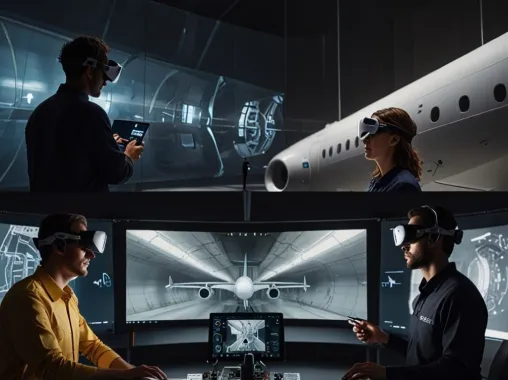Table of Contents
- Introduction
- Exploring the Metaverse’s Potential in Aerospace
- Addressing Potential Challenges
- Examples of Successful Metaverse Adoption in Aerospace
- Conclusion
Introduction
With the rapid pace of technological advancements, new opportunities are emerging across various industries, including aerospace. The metaverse—a comprehensive and interactive virtual environment—has attracted considerable attention within the aerospace sector. Investigating how this technology can be leveraged in aerospace reveals promising and exciting new possibilities.
The aerospace industry has always been at the forefront of technological innovation, pushing the boundaries of exploration and human travel. In recent years, this industry has turned its attention to the metaverse, a virtual, interconnected space where the physical and digital worlds converge. This integration provides exciting possibilities for the aerospace industry.
The adoption of the metaverse in the aerospace industry holds great potential for transformation. This technology offers new dimensions for research, design, training, and collaboration. In the metaverse, aerospace engineers will be able to examine complex systems, from aircraft design to propulsion systems, in a fully interactive and simulated environment. This helps accelerate prototyping and innovation processes.
The metaverse also enhances the quality of training and collaboration in the aerospace industry. Astronauts can train in realistic simulations, and engineers and teams worldwide can collaborate on projects simultaneously.
With advancements in the metaverse within the aerospace industry, this technology can create significant changes in education, research, design, and commercial space travel. These transformations can accelerate progress and open new frontiers in aerospace exploration.

Exploring the Metaverse’s Potential in Aerospace
The metaverse has substantial potential to transform the aerospace industry’s approach to aircraft design, testing, and manufacturing. Engineers can create virtual 3D models and simulate aircraft performance in various conditions before building physical prototypes. Key potential benefits include:
- Enhanced Simulation Training: The metaverse can significantly improve training simulations through photorealistic 3D rendering and virtual reality. This allows trainees to gain practical experience safely and develop their skills effectively.
- Streamlined Design Processes: Building physical prototypes is costly and time-consuming. In the metaverse, engineers can rapidly analyze component interfaces, aerodynamic features, and structural tolerances using dynamic digital twins, thus facilitating design and production planning.
- Real-Time Collaboration: Virtual environments in the metaverse enable simultaneous interaction among different teams, improving project collaboration and problem resolution.
- Revolutionizing Maintenance: Mixed reality headsets in the metaverse can simplify maintenance tasks in challenging locations. Technicians can use virtual guides and live support to address issues more effectively.
- Transforming Customer Experience: Future metaverse exhibitions in aerospace could offer virtual flights, cabin tours, and detailed component previews, enhancing the purchasing experience for customers.
While the concept of the metaverse in aerospace is still evolving, early applications suggest it can enhance collaboration, optimize processes, reduce costs, and create new services. The virtual world has the potential to guide the industry toward safer and brighter futures, with ongoing advancements promising unlimited potential.

Addressing Potential Challenges
Despite the aerospace industry’s enthusiasm for adopting the metaverse, this journey is fraught with challenges. Key obstacles include security concerns, implementation and training costs, and the need for seamless integration between physical and digital environments. Ethical issues related to privacy and data usage also need consideration. The following challenges must be addressed:
- Technological Limitations: Current VR/AR/3D technologies may not accurately replicate the complex systems and environments found in aerospace.
- Cost and Resource Investment: Developing and implementing metaverse solutions requires significant financial and human resources.
- Interoperability Issues: Coordinating and integrating metaverse platforms and data across different companies presents challenges.
- Security and Safety Concerns: Safeguarding sensitive information and operational data in the metaverse from cyber threats and software/hardware failures is crucial.
- Change Management Challenges: Transitioning to new processes and organizational cultures requires strong leadership and effective change management.
- Regulations and Standards: New guidelines are needed to align metaverse activities with existing aerospace industry standards.
- Measuring ROI: Demonstrating cost savings and performance benefits to justify metaverse investments compared to traditional methods can be difficult.
- Connectivity Dependence: Reliable network and computational infrastructure are essential for critical aerospace applications.
- User Experience Limitations: Current technologies may not provide the natural and fatigue-free experiences required for aerospace tasks.
Addressing these challenges through careful planning is essential for effectively leveraging the metaverse’s potential.

Examples of Successful Metaverse Adoption in Aerospace
Several leading aerospace companies are already utilizing metaverse technology, providing examples of successful adoption. These instances offer a glimpse into the promising future of aerospace in the metaverse, from astronaut training and simulation to collaborative design processes. Notable examples include:
- Boeing: Conducted tests with HoloLens AR for maintenance assistance and developed a remote control concept using VR headsets.
- Airbus: Explored VR/AR for manufacturing processes such as wiring inspections and assembly previews, and is developing metaverse-enabled sales tools.
- Lockheed Martin: Partnered with Anthropic to create AI simulations for spacecraft docking, allowing trainees to practice virtually.
- Collins Aerospace: Launched a “metaverse” on the Spatial platform to enhance remote collaboration among its employees.
- GE Aviation: Utilizes VR cave environments for visualizing 3D designs of jet engines.
- SpaceX: Uses VR simulations based on game engines for training space missions in Dragon and Starship vehicles.
- NASA: Working on digital twin initiatives to create virtual versions of spacecraft, stations, and launch vehicles.
These companies are exploring initial applications and tackling challenges. As the metaverse integrates further into aerospace, its benefits are likely to become more apparent.
Conclusion
The integration of the metaverse into the aerospace industry represents a groundbreaking step toward innovation, collaboration, and exploration. This technology opens new avenues in research, training, and design, enhancing precision and safety in operations. With continuous advancements, the metaverse has the potential to revolutionize the industry and expand the frontiers of human exploration and understanding.
Table of Contents
Toggle


One Response